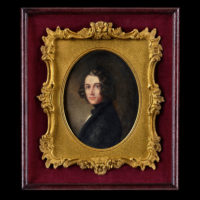 The Charles Dickens Museum has acquired a long-lost miniature of the author as a young man 175 years after it was last seen in public. The museum launched an appeal last November to raise £180,000 to secure the portrait for its collection at 48 Doughty Street, the historic home in which Dickens wrote Oliver Twist and Nicholas Nickleby.
The Charles Dickens Museum has acquired a long-lost miniature of the author as a young man 175 years after it was last seen in public. The museum launched an appeal last November to raise £180,000 to secure the portrait for its collection at 48 Doughty Street, the historic home in which Dickens wrote Oliver Twist and Nicholas Nickleby.
The miniature first re-emerged in 2017 part of a box of assorted odds-and-ends including an old recorder, a brass dish and a metal lobster that was being sold at auction in Pietermaritzburg, South Africa. The buyer bought the box for £27. The portrait was covered in yellow mold that obscured its details, but after some Googling its new owner thought it might be a depiction of Dickens. In 2018, the buyer sent the portrait to the Philip Mould & Co Gallery in London where it was conserved and studied. Free of its bilious crust, the portrait was identified as the portrait whose whereabouts have been unknown for more than 170 years.
It was painted in late 1843 by Margaret Gillies, one of the foremost miniaturists of her time and a particular favorite among literary luminaries. Dickens sat for it six times during the period when he was writing A Christmas Carol. He was 31 years old. Gillies exhibited it at the Royal Academy of Arts in London in 1844, and that year a black-and-white print of it was used as the frontispiece of A New Spirit of the Age, a collection of essays about great Victorian writers, Dickens first among them.
That poor quality rendition of the portrait would become the sole extant version. Gillies wrote in 1886 that she had “lost sight of the portrait itself” and nobody else knew where it was either. Philip Mould’s researchers think it made its way to South Africa in the 1860s with one of the sons of George Eliot’s partner George Henry Lewes. Gillies’ daughter was married to another of Lewes’ sons and the families were close.
It will go on display starting October 24th and is expected to be a regular feature of the museum’s holiday celebrations. The watercolor is fragile so it won’t be on display all the time to ensure the long-term preservation of its paint.
“yellow mold” cleaned by “Phillip Mould”?; would be nice to see a before and after picture.
Philip Mould refers to ‘fungus’, but nowhere can I find a word on the material constituents of the portrait.
Is it on ivory?
Paper?
Is the frame gutta percha?
It is great that it is back home.
The speckled surface of the face in the enlargement confirms it is decidedly painted on ivory.
The lack of as-found condition images bugged me also. The painting was successfully treated by an unnamed V&A paintings conservator, and its unsightly mold problem is illustrated in a rather plummy press release video produced by Philip Mould:
https://www.youtube.com/watch?v=NGiJTEkPPBs
Great link, just what I wanted. Thanks for commenting.
Thank you for sharing the link. What an interesting way for such a great treasure to
found again.